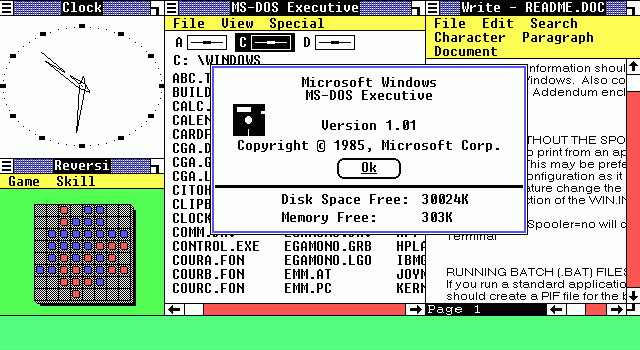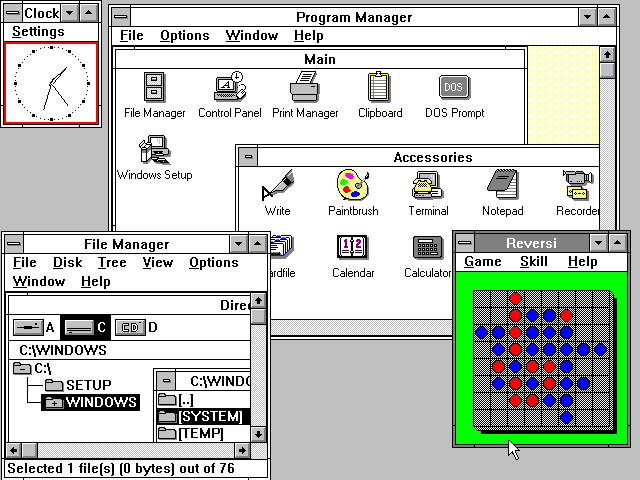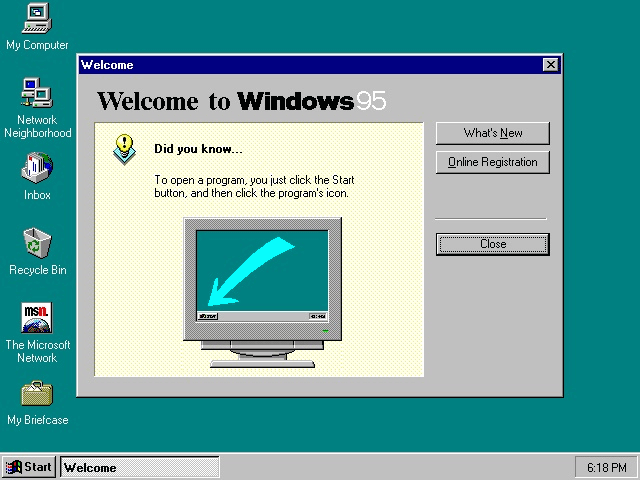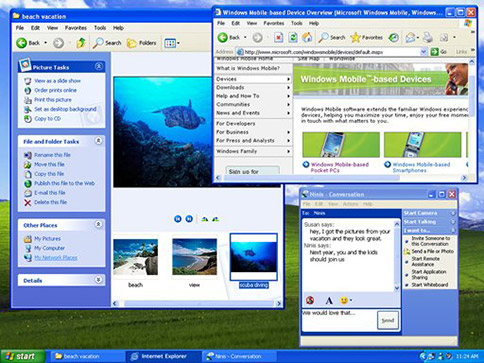The year 2015 was a milestone for the technology realm. Both eBay and Amazon ditched their teenager tags and celebrated 20 years in business, while IMDb turned 25. Elsewhere, the humble .com domain name reached 30 years of age, as the first dot-com domain was registered in March 1985.
However, 1985 was a notable year for something else: Microsoft’s efforts to bring a 16-bit graphical user interface (GUI) to the consumer realm were realized. Though its origins can be traced back to 1981 under a project called “Interface Manager,” the Windows brand was announced in 1983, and the final Windows 1.0 arrived in November 20, 1985 — 30 years ago today.
The main selling point of Windows was that it promised an alternative to MS-DOS commands (though it was still MS-DOS based) — it offered a more natural, user-friendly interface that let you point and click with a mouse. It also had drop-down menus, dialog boxes, scroll bars, and other tools that would become familiar to millions of people globally.
The first incarnation of Windows also had some notable programs built in — Paint, Notepad (I still use this), Calculator (and this), a host of other useful tools such as a clock, and a game called Reversi.
Over the past 30 years, Microsoft has launched a myriad of Windows versions, each advancing (for the most part) on the previous incarnation to suit the technologies of the time.
In December 1987, Microsoft rolled out Windows 2.0, featuring more memory, desktop icons, keyboard shortcuts, and the ability to “overlap” windows on the screen. This was followed by Windows 3.0 in 1990 and Windows 3.1 two years later. It was with these versions that Windows really started to take shape and look like the kind of interface you would maybe recognize today. It also supported the new Intel 386 processor, which meant that programs could run faster, while Program Manager, File Manager, and Print Manager were given their debut.
As a side note, 1990 also saw the birth of Solitaire, in Windows 3.0.
Windows NT followed in July 1993, its first 32-bit operating system designed to address the growing need for more powerful computing in businesses. “Windows NT represents nothing less than a fundamental change in the way that companies can address their business computing requirements,” said Microsoft cofounder Bill Gates at the time.
Windows 95, launched in August 1995, heralded the arrival of the modern PC era. Multimedia games, software, and — drum roll — dial-up networking and Internet support were the name of the game, with Internet Explorer thrown into the mix.
It also had newfangled Plug and Play capabilities that made it easier to install hardware. Windows 95 also saw the arrival of the much-loved Comic Sans font, which originally arrived in a program called 3D Movie Maker.
Over the next 20 years, Microsoft would launch version after version of Windows, starting with Windows 98 in June 1998, the final consumer-focused version to be based on MS-DOS, followed by Windows 2000 and Windows ME in 2000.
However, the next major milestone launch came in October 2001, when Microsoft launched Windows XP, which sported a much more modern look. It was also designed firmly with the Internet in mind, with fears of “viruses” allayed somewhat by regular security updates downloaded from the Internet.
The hugely unpopular Windows Vista launched in 2006, followed by Windows 7 in 2009, at a time when laptops were more popular than desktops and Wi-Fi was the order of the day. A notable introduction to Windows 7 was Windows Touch, which catered to touchscreen devices.
Windows 8, when it was launched in 2012, was arguably the biggest departure for Microsoft to date. The operating system adopted a hybrid approach, one that attempted to bridge the laptop/tablet divide by accommodating traditional desktop software and the app ecosystem heralded by the rise of Android and iOS on mobile. But for many, it was a confusing, counterintuitive setup.
Following the release of Windows 8.1, Microsoft skipped “Windows 9” altogether and launched Windows 10 this summer. With this version, Microsoft attempted to correct many of the things it had gotten wrong with Windows 8.
In its quest to encourage developers to create apps for its device ecosystem, Microsoft adopted a “universal” application approach, meaning that apps can work across PC, tablet, smartphones, consoles, and more.
It’s difficult to predict what Windows will look like 30 years from now. But with the Internet of Things in full swing, cloud computing on the rise, traditional PCs purportedly on their way out, and driverless cars a work in progress, the Windows of the future will be a very different beast indeed.
VentureBeat's mission is to be a digital town square for technical decision-makers to gain knowledge about transformative enterprise technology and transact. Learn More





